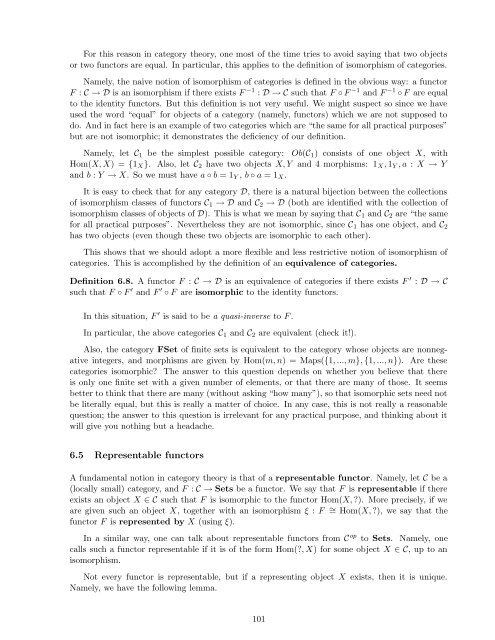Lecture notes for Introduction to Representation Theory
Lecture notes for Introduction to Representation Theory
Lecture notes for Introduction to Representation Theory
Create successful ePaper yourself
Turn your PDF publications into a flip-book with our unique Google optimized e-Paper software.
For this reason in category theory, one most of the time tries <strong>to</strong> avoid saying that two objects<br />
or two func<strong>to</strong>rs are equal. In particular, this applies <strong>to</strong> the definition of isomorphism of categories.<br />
Namely, the naive notion of isomorphism of categories is defined in the obvious way: a func<strong>to</strong>r<br />
F : C ⊃ D is an isomorphism if there exists F −1 : D ⊃ C such that F ∞ F −1 and F −1 ∞ F are equal<br />
<strong>to</strong> the identity func<strong>to</strong>rs. But this definition is not very useful. We might suspect so since we have<br />
used the word “equal” <strong>for</strong> objects of a category (namely, func<strong>to</strong>rs) which we are not supposed <strong>to</strong><br />
do. And in fact here is an example of two categories which are “the same <strong>for</strong> all practical purposes”<br />
but are not isomorphic; it demonstrates the deficiency of our definition.<br />
Namely, let C 1 be the simplest possible category: Ob(C 1 ) consists of one object X, with<br />
Hom(X, X) = {1 X }. Also, let C 2 have two objects X, Y and 4 morphisms: 1 X , 1 Y , a : X ⊃ Y<br />
and b : Y ⊃ X. So we must have a ∞ b = 1 Y , b ∞ a = 1 X .<br />
It is easy <strong>to</strong> check that <strong>for</strong> any category D, there is a natural bijection between the collections<br />
of isomorphism classes of func<strong>to</strong>rs C 1 ⊃ D and C 2 ⊃ D (both are identified with the collection of<br />
isomorphism classes of objects of D). This is what we mean by saying that C 1 and C 2 are “the same<br />
<strong>for</strong> all practical purposes”. Nevertheless they are not isomorphic, since C 1 has one object, and C 2<br />
has two objects (even though these two objects are isomorphic <strong>to</strong> each other).<br />
This shows that we should adopt a more flexible and less restrictive notion of isomorphism of<br />
categories. This is accomplished by the definition of an equivalence of categories.<br />
Definition 6.8. A func<strong>to</strong>r F : C ⊃ D is an equivalence of categories if there exists F : D ⊃ C<br />
such that F ∞ F and F ∞ F are isomorphic <strong>to</strong> the identity func<strong>to</strong>rs.<br />
In this situation, F is said <strong>to</strong> be a quasi-inverse <strong>to</strong> F .<br />
In particular, the above categories C 1 and C 2 are equivalent (check it!).<br />
Also, the category FSet of finite sets is equivalent <strong>to</strong> the category whose objects are nonnegative<br />
integers, and morphisms are given by Hom(m, n) = Maps({1, ..., m}, {1, ..., n}). Are these<br />
categories isomorphic? The answer <strong>to</strong> this question depends on whether you believe that there<br />
is only one finite set with a given number of elements, or that there are many of those. It seems<br />
better <strong>to</strong> think that there are many (without asking “how many”), so that isomorphic sets need not<br />
be literally equal, but this is really a matter of choice. In any case, this is not really a reasonable<br />
question; the answer <strong>to</strong> this question is irrelevant <strong>for</strong> any practical purpose, and thinking about it<br />
will give you nothing but a headache.<br />
6.5 Representable func<strong>to</strong>rs<br />
A fundamental notion in category theory is that of a representable func<strong>to</strong>r. Namely, let C be a<br />
(locally small) category, and F : C ⊃ Sets be a func<strong>to</strong>r. We say that F is representable if there<br />
exists an object X C such that F is isomorphic <strong>to</strong> the func<strong>to</strong>r Hom(X, ?). More precisely, if we<br />
are given such an object X, <strong>to</strong>gether with an isomorphism : F = ∪ Hom(X, ?), we say that the<br />
func<strong>to</strong>r F is represented by X (using ).<br />
In a similar way, one can talk about representable func<strong>to</strong>rs from C op <strong>to</strong> Sets. Namely, one<br />
calls such a func<strong>to</strong>r representable if it is of the <strong>for</strong>m Hom(?, X) <strong>for</strong> some object X C, up <strong>to</strong> an<br />
isomorphism.<br />
Not every func<strong>to</strong>r is representable, but if a representing object X exists, then it is unique.<br />
Namely, we have the following lemma.<br />
101

















